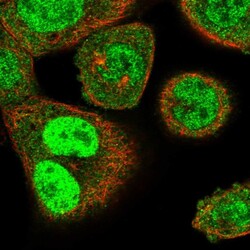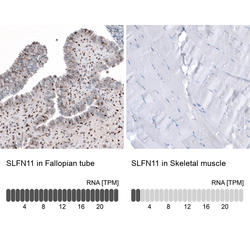Antibody data
- Antibody Data
- Antigen structure
- References [9]
- Comments [0]
- Validations
- Immunocytochemistry [1]
- Immunohistochemistry [1]
Submit
Validation data
Reference
Comment
Report error
- Product number
- HPA023030 - Provider product page

- Provider
- Atlas Antibodies
- Proper citation
- Atlas Antibodies Cat#HPA023030, RRID:AB_1856613
- Product name
- Anti-SLFN11
- Antibody type
- Polyclonal
- Description
- Polyclonal Antibody against Human SLFN11, Gene description: schlafen family member 11, Alternative Gene Names: FLJ34922, Validated applications: WB, IHC, ICC, Uniprot ID: Q7Z7L1, Storage: Store at +4°C for short term storage. Long time storage is recommended at -20°C.
- Reactivity
- Human
- Host
- Rabbit
- Conjugate
- Unconjugated
- Isotype
- IgG
- Vial size
- 100 µl
- Concentration
- 0.2 mg/ml
- Storage
- Store at +4°C for short term storage. Long time storage is recommended at -20°C.
- Handling
- The antibody solution should be gently mixed before use.
Submitted references Dynamic expression of Schlafen 11 (SLFN11) in circulating tumour cells as a liquid biomarker in small cell lung cancer
SLFN11 is Widely Expressed in Pediatric Sarcoma and Induces Variable Sensitization to Replicative Stress Caused By DNA-Damaging Agents
Immunohistochemical analysis of SLFN11 expression uncovers potential non-responders to DNA-damaging agents overlooked by tissue RNA-seq
BRCAness, SLFN11, and RB1 loss predict response to topoisomerase I inhibitors in triple-negative breast cancers
SLFN11 inhibits hepatocellular carcinoma tumorigenesis and metastasis by targeting RPS4X via mTOR pathway.
SLFN11 can sensitize tumor cells towards IFN-γ-mediated T cell killing
PARP Inhibitor Activity Correlates with SLFN11 Expression and Demonstrates Synergy with Temozolomide in Small Cell Lung Cancer
Immunofluorescence and fluorescent-protein tagging show high correlation for protein localization in mammalian cells
Codon-usage-based inhibition of HIV protein synthesis by human schlafen 11
Zhang B, Stewart C, Wang Q, Cardnell R, Rocha P, Fujimoto J, Solis Soto L, Wang R, Novegil V, Ansell P, He L, Fernandez L, Jendrisak A, Gilbertson C, Schonhoft J, Byun J, Jones J, Anderson A, Aparicio A, Tran H, Negrao M, Zhang J, Wang W, Wistuba I, Wang J, Wenstrup R, Byers L, Gay C
British Journal of Cancer 2022;127(3):569-576
British Journal of Cancer 2022;127(3):569-576
SLFN11 is Widely Expressed in Pediatric Sarcoma and Induces Variable Sensitization to Replicative Stress Caused By DNA-Damaging Agents
Gartrell J, Mellado-Largarde M, Clay M, Bahrami A, Sahr N, Sykes A, Blankenship K, Hoffmann L, Xie J, Cho H, Twarog N, Connelly M, Yan K, Yu J, Porter S, Pruett-Miller S, Neale G, Tinkle C, Federico S, Stewart E, Shelat A
Molecular Cancer Therapeutics 2021;20(11):2151-2165
Molecular Cancer Therapeutics 2021;20(11):2151-2165
Immunohistochemical analysis of SLFN11 expression uncovers potential non-responders to DNA-damaging agents overlooked by tissue RNA-seq
Takashima T, Sakamoto N, Murai J, Taniyama D, Honma R, Ukai S, Maruyama R, Kuraoka K, Rajapakse V, Pommier Y, Yasui W
Virchows Archiv 2020;478(3):569-579
Virchows Archiv 2020;478(3):569-579
BRCAness, SLFN11, and RB1 loss predict response to topoisomerase I inhibitors in triple-negative breast cancers
Coussy F, El-Botty R, Château-Joubert S, Dahmani A, Montaudon E, Leboucher S, Morisset L, Painsec P, Sourd L, Huguet L, Nemati F, Servely J, Larcher T, Vacher S, Briaux A, Reyes C, La Rosa P, Lucotte G, Popova T, Foidart P, Sounni N, Noel A, Decaudin D, Fuhrmann L, Salomon A, Reyal F, Mueller C, Ter Brugge P, Jonkers J, Poupon M, Stern M, Bièche I, Pommier Y, Marangoni E
Science Translational Medicine 2020;12(531)
Science Translational Medicine 2020;12(531)
SLFN11 inhibits hepatocellular carcinoma tumorigenesis and metastasis by targeting RPS4X via mTOR pathway.
Zhou C, Liu C, Liu W, Chen W, Yin Y, Li CW, Hsu JL, Sun J, Zhou Q, Li H, Hu B, Fu P, Atyah M, Ma Q, Xu Y, Dong Q, Hung MC, Ren N
Theranostics 2020;10(10):4627-4643
Theranostics 2020;10(10):4627-4643
SLFN11 can sensitize tumor cells towards IFN-γ-mediated T cell killing
Dieli F, Mezzadra R, de Bruijn M, Jae L, Gomez-Eerland R, Duursma A, Scheeren F, Brummelkamp T, Schumacher T
PLOS ONE 2019;14(2):e0212053
PLOS ONE 2019;14(2):e0212053
PARP Inhibitor Activity Correlates with SLFN11 Expression and Demonstrates Synergy with Temozolomide in Small Cell Lung Cancer
Lok B, Gardner E, Schneeberger V, Ni A, Desmeules P, Rekhtman N, de Stanchina E, Teicher B, Riaz N, Powell S, Poirier J, Rudin C
Clinical Cancer Research 2017;23(2):523-535
Clinical Cancer Research 2017;23(2):523-535
Immunofluorescence and fluorescent-protein tagging show high correlation for protein localization in mammalian cells
Stadler C, Rexhepaj E, Singan V, Murphy R, Pepperkok R, Uhlén M, Simpson J, Lundberg E
Nature Methods 2013;10(4):315-323
Nature Methods 2013;10(4):315-323
Codon-usage-based inhibition of HIV protein synthesis by human schlafen 11
Li M, Kao E, Gao X, Sandig H, Limmer K, Pavon-Eternod M, Jones T, Landry S, Pan T, Weitzman M, David M
Nature 2012;491(7422):125-128
Nature 2012;491(7422):125-128
No comments: Submit comment
Supportive validation
- Submitted by
- Atlas Antibodies (provider)
- Main image

- Experimental details
- Immunofluorescent staining of human cell line A-431 shows localization to nucleoplasm & cytosol.
- Sample type
- Human
Supportive validation
- Submitted by
- Atlas Antibodies (provider)
- Enhanced method
- Orthogonal validation
- Main image

- Experimental details
- Immunohistochemistry analysis in human fallopian tube and skeletal muscle tissues using HPA023030 antibody. Corresponding SLFN11 RNA-seq data are presented for the same tissues.
- Sample type
- Human
- Protocol
- Protocol
 Explore
Explore Validate
Validate Learn
Learn Western blot
Western blot Immunocytochemistry
Immunocytochemistry